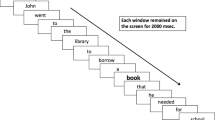Abstract
This study examined the role of context effects in the processing of homophones in Chinese and Chinese-English bilingual speech. In Experiment 1, Chinese speakers were presented with successively gated portions of a homophone in a sentence context, and they identified the homophone on the basis of its increasing acoustic information. In Experiment 2, Chinese-English bilinguals were presented with a cross-language homophone in a sentence context, and they named a visual probe that had or did not have phonological overlaps with the homophone. Results indicate that prior sentence context has an early effect on the disambiguation of various homophone meanings, shortly after the acoustic onset of the word, in both monolingual and bilingual situations. The results are accounted for by interactive activation models of lexical processing, in which the recognition of a homophone is a result of the interactions among phonological, lexical, and contextual information at an early stage.
Similar content being viewed by others
References
Cohen, J., MacWhinney, B., Flatt, M. & Provost, J. (1993). PsyScope: A new graphic interactive environment for designing psychology experiments, Behavior Research Methods, Instruments, and Computers 25: 257–271.
Cotton, S. & Grosjean, F. (1984). The gating paradigm: A comparison of successive and individual presentation formats, Perception and Psychophysics 35: 41–48.
Fodor, J. A. (1983). The modularity of mind: An essay on faculty psychology. Cambridge, MA: The MIT Press.
Forster, K. (1981). Priming and the effects of sentence and lexical contexts on naming time: Evidence for autonomous lexical processing, Quarterly Journal of Experimental Psychology 33: 465–495.
Grosjean, F. (1980). Spoken word recognition processes and the gating paradigm, Perception and Psychophysics 28: 267–283.
Grosjean, F. (1988). Exploring the recognition of guest words in bilingual speech, Language and Cognitive Processes 3: 233–274.
Grosjean, F., Dommergues, J., Cornu, E., Guillelmon, D. & Besson, C. (1994). The gender-marking effect in spoken word recognition, Perception and Psychophysics 56: 590–598.
Ho, K. (1992). Cantonese frequent words pronunciation dictionary. Chinese Division, Institute of Education in Language, Hong Kong Education Department.
Institute of Linguistics, The Academy of Social Sciences (1985). Xianda Hanyu Cidian [Modern Chinese Dictionary]. Beijing: Commercial Press.
Kawamoto, A.H. (1993). Non-linear dynamics in the resolution of lexical ambiguity: A parallel distributed processing account, Journal of Memory and Language 32: 474–516.
Li, P. (1994). Understanding the time course of sentence comprehension: A sentence gating study in Mandarin Chinese. In Chang, H-W., Huang, J-T., Hue, W. & Tzeng, O. (eds.), Advances in the study of Chinese language processing, Vol. 1 (pp. 303–323). Taipei: National Taiwan University Press.
Li, P. (1996a). The temporal structure of spoken sentence comprehension in Chinese, Perception and Psychophysics 58: 571–586.
Li, P. (1996b). Spoken word recognition of code-switched words by Chinese-English bilinguals, Journal of Memory and Language 35: 757–774.
Li, P. (1998). Crosslinguistic variation and sentence processing: The case of Chinese. In D. Hillert (ed.), Sentence processing: A cross-linguistic perspective. San Diego, CA: Academic Press (in press).
Li, P., Bates, E. & MacWhinney, B. (1993). Processing a language without inflections: A reaction time study of sentence interpretation in Chinese, Journal of Memory and Language 32: 169–192.
Li, P. & Yip, M. (1996). Lexical ambiguity and context effects in spoken word recognition: Evidence from Chinese. In G. Cottrell (ed.), Proceedings of the 18th Annual Conference of the Cognitive Science Society (pp. 228–232). Hillsdale, NJ: Erlbaum.
The Linguistic Society of Hong Kong (1994). The LSHK Cantonese Romanization Scheme, Jyutping. LSHK Newsletter, No. 17.
Marslen-Wilson, W. (1987). Functional parallelism in spoken word-recognition, Cognition 25: 71–102.
Marslen-Wilson, W., Tyler, L., Waksler, R., & Older, L. (1994). Morphology and meaning in the English mental lexicon, Psychological Review 101: 3–33.
Marslen-Wilson, W. D. & Welsh, A. (1978). Processing interactions and lexical access during word recognition in continuous speech, Cognitive Psychology 10: 29–63.
McClelland, J. L. (1987). The case for interactionism in language processing. In M. Coltheart (ed.), Attention and performance Vol. 12: The psychology of reading (pp. 3–36). Hillsdale, NJ: Erlbaum.
McClelland, J. L. & Elman, J. (1986). Interactive processes in speech perception: The TRACE model. In: McClelland, J. L., Rumelhart, D. E. & the PDP Research Group (eds.), Parallel distributed processing: Explorations in the microstructure of cognition, Vol. 2 (pp. 58–121). Cambridge, MA: The MIT Press.
Onifer, W. & Swinney, D. A. (1981). Accessing lexical ambiguities during sentence comprehension: Effects of frequency of meaning and contextual bias, Memory & Cognition 9: 225–236.
Rumelhart, D., McClelland, J. & the PDP Research Group (1986). Parallel distributed processing; Explorations in the microstructure of cognition, Vol. 1, Cambridge, MA: The MIT Press.
Seidenberg, M.S., Tanenhaus, M.J., Leiman, J.M. & Bienkowski, M. (1982). Automatic access of the meanings of ambiguous words in context: Some limitations of knowledge-based processing, Cognitive Psychology 14: 538–559.
Simpson, G. (1981). Meaning dominance and semantic context in the processing of lexical ambiguity, Journal of Verbal Learning and Verbal Behavior 20: 120–136.
Simpson, G.B. & Krueger, M.A. (1991). Selective access of homograph meanings in sentence context, Journal of Memory and Language 30: 627–643.
Small, S., Cottrell, G. & Tanenhaus, M. (1988). Lexical ambiguity resolution: perspectives from psycholinguistics, neuropsychology, and artificial intelligence. San Mateao, CA: Morgan Kaufmann Publishers.
Swinney, D.A. (1979). Lexical access during sentence comprehension: (Re)consideration of context effects, Journal of Verbal Learning and Verbal Behavior 18: 645–659.
Tabossi, P. (1988). Accessing lexical ambiguity in different types of sentential contexts, Journal of Memory and Language 27: 324–340.
Tyler, L. & Wessels, J. (1985). Is gating an on-line task? Evidence from naming latency data, Perception and Psychophysics 38: 217–222.
Author information
Authors and Affiliations
Rights and permissions
About this article
Cite this article
Li, P., Yip, M.C. Context effects and the processing of spoken homophones. Reading and Writing 10, 223–243 (1998). https://doi.org/10.1023/A:1008091816322
Issue Date:
DOI: https://doi.org/10.1023/A:1008091816322




